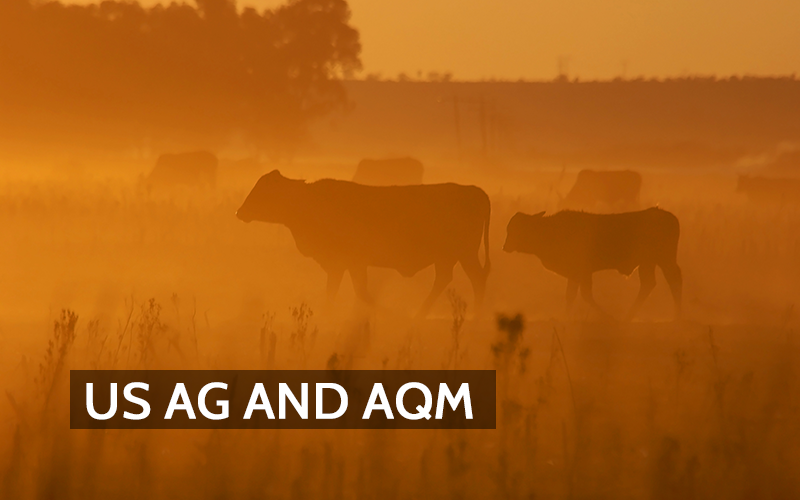Air quality monitoring has become an essential part of sustainable agricultural practices in the United States. Agriculture contributes to air pollution through emissions of ammonia, methane, and particulate matter, but it also faces adverse effects from poor air quality. Ensuring that air quality standards are met in agricultural operations involves a balance between regulation, innovation, and cooperation across industries. This article explores the considerations and regulations surrounding air quality and agriculture, highlights the challenges and gaps in addressing this issue, and examines the key goals that guide the nation’s efforts.
Regulations Governing Air Quality in Agriculture
In the United States, the Environmental Protection Agency (EPA) establishes air quality standards under the Clean Air Act (CAA). The National Ambient Air Quality Standards (NAAQS) set permissible levels for six criteria pollutants: particulate matter (PM), ground-level ozone, carbon monoxide, sulfur dioxide, nitrogen dioxide, and lead. Agriculture, particularly livestock and crop production, contributes to some of these pollutants through ammonia emissions from manure, methane from enteric fermentation, and dust generated during tilling and harvesting.
While the Clean Air Act provides the overarching framework, enforcement and specific agricultural considerations often fall to state and local authorities. For example, in California, stringent regulations like the state’s Global Warming Solutions Act aim to reduce greenhouse gas emissions, including methane from dairy farms. However, many states lack similarly robust programs, leading to inconsistent enforcement across the country.
Agricultural operations must also comply with the Emergency Planning and Community Right-to-Know Act (EPCRA), which mandates reporting of hazardous emissions like ammonia and hydrogen sulfide if they exceed threshold quantities. However, small to mid-sized farms often qualify for exemptions, which can lead to underreporting and data gaps.
Challenges in Addressing Air Quality in Agriculture
One of the most significant challenges in improving air quality in agriculture is the diffuse nature of emissions. Unlike industrial facilities, which have identifiable sources of pollution, agricultural emissions often come from multiple small and dispersed sources, making monitoring and regulation more difficult.
Technological Barriers: Many farms lack access to affordable and reliable air quality monitoring tools. While advanced sensors and satellite technologies are becoming more available, their cost remains prohibitive for smaller operations. Additionally, there is limited standardization in how agricultural air quality data is collected and analyzed, further complicating regulatory compliance.
Economic Pressures: Implementing air quality mitigation strategies can be costly. Farmers must weigh the expense of upgrading equipment or altering practices against slim profit margins. For instance, adopting anaerobic digesters to reduce methane emissions from livestock manure involves significant upfront investment that not all farmers can afford.
Knowledge Gaps: Research into the exact impact of agricultural emissions on regional air quality and public health is still evolving. While the role of methane as a greenhouse gas is well-documented, understanding the interaction between ammonia emissions and fine particulate matter formation requires more study. This lack of clarity can delay the development of targeted mitigation strategies.
Gaps in Current Policies and Practices
Lack of Uniform Standards: Variability in state-level regulations creates an uneven playing field for farmers and limits the effectiveness of national strategies. For example, a farm in a state with lax air quality enforcement may face fewer compliance costs than one in a more regulated state, leading to disparities.
Limited Incentives for Change: Existing federal programs, like the USDA’s Environmental Quality Incentives Program (EQIP), provide some financial assistance to farmers implementing conservation practices. However, these programs are often underfunded and fail to address air quality comprehensively.
Underrepresentation of Small Farms: Small farms, which make up a significant portion of U.S. agriculture, are often exempt from reporting requirements or regulatory scrutiny. While this reduces the administrative burden on smallholders, it also creates significant data gaps, hindering the development of effective policies.
Key Goals and Milestones
Despite these challenges, there are clear goals and milestones that guide the nation’s efforts to improve air quality in agriculture:
- Reducing Methane Emissions: The United States is a participant in the Global Methane Pledge, which aims to cut methane emissions by at least 30% by 2030 compared to 2020 levels. Achieving this goal requires significant investment in technologies like anaerobic digesters and feed additives that reduce enteric fermentation emissions.
- Improving Air Quality Monitoring: Expanding the availability of affordable monitoring technologies is a priority. Initiatives like the EPA’s Air Quality Flag Program, which provides communities with real-time air quality updates, could be adapted for agricultural applications.
- Enhancing Research and Education: Increased funding for research into the impacts of agricultural emissions and the effectiveness of mitigation strategies is essential. Educational programs targeting farmers can also help bridge knowledge gaps and encourage the adoption of best practices.
- Encouraging Sustainable Practices: Programs that promote cover cropping, reduced tillage, and precision agriculture not only improve soil health and water quality but also reduce dust and greenhouse gas emissions. The USDA’s Climate-Smart Agriculture and Forestry initiative is an example of efforts to align agricultural practices with environmental goals.
The Path Forward
Addressing air quality in agriculture requires a collaborative approach that includes farmers, policymakers, researchers, and technology providers. By harmonizing regulations, improving access to monitoring tools, and incentivizing sustainable practices, the U.S. can make significant strides toward achieving its air quality and climate goals. While challenges remain, the potential for innovation and progress in this field is immense, showing the importance of continued investment and cooperation.
By taking a proactive stance on air quality monitoring, the agricultural sector can not only meet regulatory requirements but also enhance its sustainability and resilience in the face of environmental and economic challenges.
- https://www.epa.gov/agriculture/agriculture-and-air-quality
- https://www.epa.gov/epcra
- https://ww2.arb.ca.gov/capp/cst/rdi/air-quality-and-emissions-data
- https://www.globalmethanepledge.org/
- https://www.airnow.gov/air-quality-flag-program/
- https://www.farmers.gov/conservation/climate-smart


